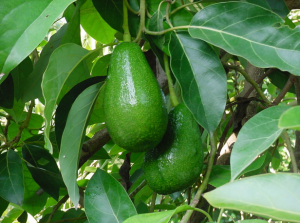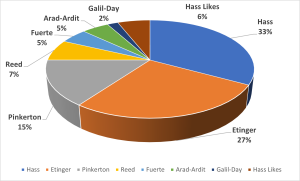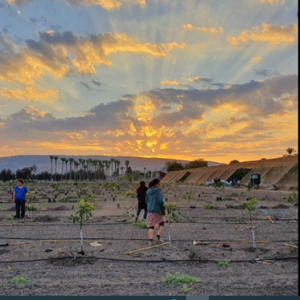israel avocados in 2021

- Haskelberg Nurseries
- 01.05.2023
- 8 Minutes

- Haskelberg Nurseries
- 01.05.2023
- 8 Minutes
By Udi Haskelberg, CEO, Haskelberg Nurseries LTD and Hadar Cohen, senior avocado consultant
History and general background
Avocados first reached Israel on a small scale in the 1930s, with an attempt to acclimatize them.
The first commercial orchards were planted in the late 1950s, and towards the end of the 1960s the avocado sector began to gain momentum and become known in the market.
By the 1970s, 11,000 hectares (27181 acres) had already been planted in the country.
Planting at this time was disorganized, and there was no attention to type, quality, or suiting the rootstock to the conditions of the area. Moreover, in those years, no care was taken to ensure that the plant material was free of viruses.
Over time, the volume of plantings increased, using local Mexican rootstocks on which different varieties were grafted, mainly Fuerte, and later also Hass and Etinger (an Israeli pollinator variety).
From the mid-1980s until the early 2000s, the avocado industry in Israel was in crisis for a number of reasons. The main reasons are as follows:
- Extreme cold events
- Shortage of good quality water
- Use of rootstocks that were not suited to the water and soil quality
- Spread of phytotoxic fungi to avocados
- Price decreases in the markets
- Less harvest volume than projected
This crisis led to the uprooting of around 7,000 hectares (17297 acres) of mature orchards.
Beginning in the middle of the first decade of the 2000s, the avocado industry experienced a resurgence. The quotas of good quality water for agriculture increased, thanks to seawater desalination and use of reclaimed water for agriculture. In addition, new varieties of avocado were added, such as Ardit, Pinkerton and Reed, which have expanded the options for growers.
New plantings began to take place, increasing over the past 10 years.
At the same time, there has been a significant improvement in the quality of the plant material (rootstocks and grafts) and in the professional understanding of those involved in the field, from nurseries to growers.With the increase in consumption around the world, demand also increased and the return for the growers became attractive. Plantings were expanded to areas whose suitability for growing avocados was uncertain, especially in terms of soil type, water quality and climate.
From this period on, the emphasis was placed on the importance of suiting the rootstock and variety to the planting area conditions and their contribution to the quality of the orchard and increasing fertility.
Growers began to use West Indian rootstocks and vegetative rootstocks that were more resistant to decreased water quality (salinity) and soil diseases, a database of dozens of tested rootstocks was created, led by Prof. Avraham Ben Yaakov, and at the same time new varieties were also introduced for the summer period (such as the Galil and Day varieties), making it possible to produce a yield almost all year round.
Current status
Today, there are around 13,000 hectares (32123 acres) planted in the country. This total includes10,000 hectares (24,710 acres) of mature orchards and 3,000
hectares (7,413 acres) young.
The rate of planting in recent years is 1,000 hectares (2,471 acres) per year.
Consumption per capita in Israel today is 9 kilograms (19.8 pounds) – one of the highest in the world – and it is believed that consumption will increase to 11 kg (24.2 lbs)
per capita in the coming years.

Breakdown of varieties:
Hass is the most popular variety, mainly for the international market.
The local market tends more towards green skin varieties, and in particular Etinger.

Today there are more and more plantings of Hass-like varieties such as Lamb Hass, Gem and Maluma, which are characterized by easier growth and fertility than Hass.
The Gem variety is particularly common in the Jordan Valley area, where the hot, dry climate does not allow for growing Hass.

Breakdown of rootstocks:
The most common rootstocks today in Israel are West Indian seed rootstocks (Degania 117, Ashdot 17, Fairchild, and others), which constitute about 80% of the plantings.
In recent years, the volume of plantings of leading vegetative rootstocks has increased, from the selection of rootstocks cultivated by Prof. Avraham Ben Yaakov, and from the Canacado brand rootstock database (www.canacado.com). The objective is to achieve more uniform, healthy and fertile orchards in a variety of areas.
Growing areas:
Growing areas in Western Galilee and the coastal plain account for over 50% of plantings. Another 20% are in the eastern valleys (Jordan Valley and Upper Galilee); around 15% are in the western Negev; and the rest are scattered throughout the country.

Israel Avocaods Yields and market:
Yields in recent years are about 110-120,000 tons (220 – 240 million pounds) per year. Of this, slightly more than half is for export, and the rest is directed to the local market. This year, 2021, is expected to be a particularly fruitful year, with a yield of about 200,000 tons (400 million pounds).
The average yield for Hass is 13 tons per hectare (10,400 pounds per acre); with the green varieties it reaches 18 tons per hectare (14,400 pounds per acre).
In certain areas yields can also reach over 20 tons per hectare (16,000 pounds per acre).
Israel’s main export destinations are in Europe – Germany, England and France, (primarily the black varieties).
Green varieties are mainly exported to Eastern Europe.
Work is underway at present to open up marketing to Asia.
For the domestic market, the most sought after variety is Etinger.
R&D activities
There is intensive research and development activity in Israel, characterized by considerable cooperation between all entities – the nurseries, the growers and various research bodies that contribute to developing the industry.
The main effort is focused on increasing crops and reducing alternate bearings
There are projects for improving new varieties, some of which have already been planted in various experimental plots.
There is also great emphasis on adapting different rootstocks to a variety of conditions – a climate that is becoming extreme, different soils and a constant decline in water qualities. For this purpose, there is a unique selection of rootstocks in Israel under the Canacado brand, tested in a variety of experimental plots in Israel and around the world, with the aim of addressing the changing conditions.
Economic feasibility
Prices:
In the late 1990s, mainly due to the influx of Mexican fruit to Europe, prices in Israel dropped to $0.5 per kg to the grower.
Later, when the issue was regulated (and the fruit from Mexico was marketed mainly to the United States), and the euro exchange rate strengthened, prices rose to $1.8 per kilogram.
Today, the avocado is Israel’s main and most profitable crop.
In recent years, export prices have risen to $2.5- $3 per kilogram at the farm gate for the black varieties, mainly due to increasing demand in Europe.
In the domestic market, prices are about $0.8 to the grower.
Costs of setting up and maintaining an orchard
The cost of establishing an orchard today can reach about $18,000 per hectare ($7,200 per acre).
Ongoing maintenance is around $7,000 per hectare($2,800 per acre).
An average of $40,000 per hectare to yield ($16,000 per acre to yield).
On average, orchards in Israel become profitable after seven years.
Breakdown of costs:
- 20% water – irrigation at $0.3 per cubic meter of water, using about 11,000 cubic meters per hectare per year depending on the region.
- Manpower accounts for about 40% of growing costs – minimum wage in Israel is about $9 per hour.
- Fertilizer and nutrients – about 10%.
- The average price of a seedling in Israel today is around $14.5 for seedling rootstocks, and $19 for vegetative rootstocks.

Orchard maintenance:
- Average planting intervals are plantings of 360-550 trees per hectare (144-220 per acre). There are also denser plantings of certain varieties and rootstocks now available.
- Intensive pruning in order to encourage regeneration of the tree once a year – manual or mechanized.
- Lopping is performed twice a year in order to maintain a height that will optimize the harvest and allow light to penetrate to the lower parts of the tree.
- Pollination by honey bees (one hive per 0.2-0.3 hectares), and experiments with Bombus bees.
Growing areas:
Soil
Most soil in Israel is heavy clay, at levels of 60% clay, with alkaline pH. Planting is not carried out in soil with over 20% limestone overall.
In the south the land is mainly .
Plantings are almost always carried out in raised beds, with emphasis on drainage.
Irrigation is usually with 2 extensions per row. Irrigation, depending on the season, is between once a day and once every 3 days.
Water
Water in Israel is mostly at levels of 1.5 EC and 240-250 chlorides.
It is hoped that as seawater desalination projects progress, the quality and salinity of irrigation water will improve.
Fertilization is with 28-32 units of nitrogen per year, and 30-32 units of potassium oxide.
Since there is enough phosphorus in the water, phosphorus is hardly added to the fertilizer.
Climate
Israel has a Mediterranean climate, with summer temperatures of 31-32° C (88-90° F) during the day and 22° C (72° F) at night, and with high humidity.
In the eastern valleys, temperatures reach 36-38° C (97-100° F) during the day and 25° C (77° F) at night, with low humidity.
Once a decade there are significant cold events in some areas that cause damage. The most common solutions today are the use of fans, sprinklers, covering the orchard with nets, and especially the use of appropriate rootstocks and varieties.
Dealing with pests
In recent years, the avocado industry has been concerned with two main pests: the Botryosphaeria fungus, and the ambrosia beetle.
Various thrips pests are also present.
There is virtually no presence of the phytophthora fungus, mainly because of the alkaline soils and careful use of raised beds and drainage.
In the southern region, there is the Verticillium Wilt fungus, which originates in a previous crop of potatoes and other solanums.
As part of the rootstock experiments, several vegetative rootstocks have been found that show resistance to the fungus at different levels.
Another direction in dealing with the fungus is primarily through maintaining sanitation in nurseries and orchards, and using fungicides.
Future challenges
- Replacing the Hass variety with improved black varieties with a higher yield and easier maintenance that will be popular in world markets similarly to the Hass.
- Agrotechnical improvements that will increase the avocado’s resistance to extreme and exceptional climatic conditions.
- Adapting avocado rootstocks and varieties to deterioration in water quality and extreme climatic conditions.
- General summary:
Opportunity versus risk in the avocado industry
| Opportunities | Threats |
|---|---|
| Development of export to East Asia | Inability to maintain stability of yields (irregular supply) |
| Increased consumption in the domestic market | Need for irrigation with reclaimed water |
| Few plant protection issues relative to the world –
gives an advantage in production and marketing |
Lack of areas free of frost |
| High professional standard relative to the rest of the world | Competition |
| Close cooperation between research institutes and growers | Multiple green varieties in Israel’s orchards |
| Promising economic projection: years of business stability | Shortage of manpower for agriculture |
| Export-oriented branch |
Climate change: frosts in winter, hot dry winds during the flowering and ripening season |


